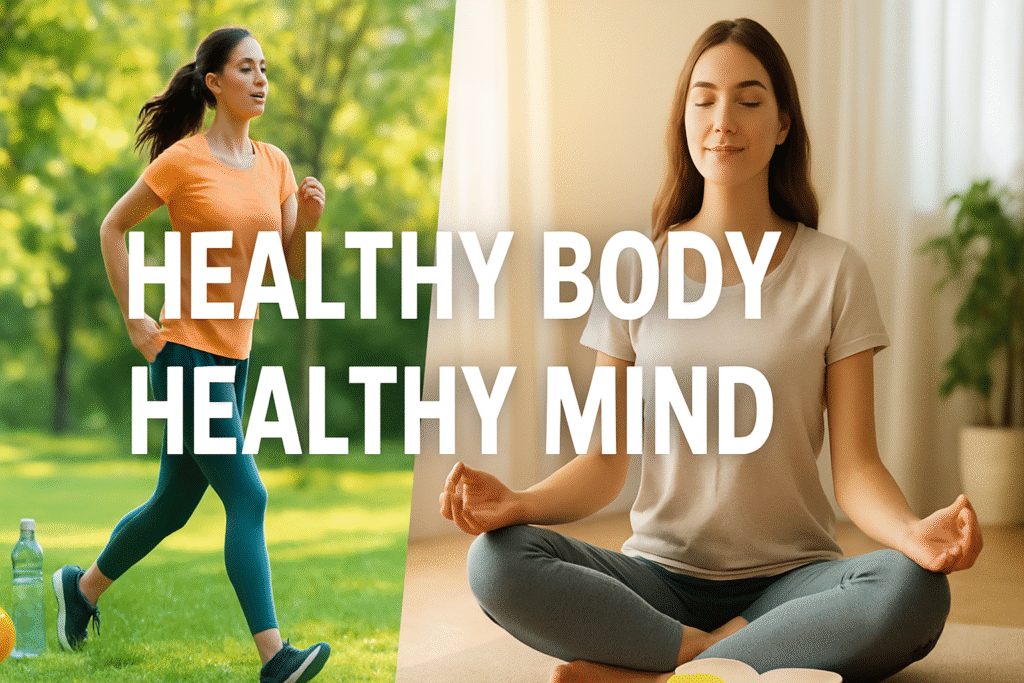Achieving a balance between physical and mental health is crucial for overall well-being. As Carolyn McGraw, a LifeGuide, notes, “The secret to a healthy lifestyle plan is making your healthy lifestyle a priority one day at a time, one week at a time, one month at a time.” This approach emphasizes the importance of gradual, sustainable changes.
Focusing on holistic wellness allows individuals to cultivate a lifestyle that nurtures both body and mind. By making small adjustments and being patient, individuals can develop habits that become routine, leading to a more balanced life.
Key Takeaways
- Prioritizing a healthy lifestyle is key to overall well-being.
- Gradual changes lead to sustainable habits.
- Holistic wellness encompasses both physical and mental health.
- Patience is essential for developing healthy routines.
- A balanced lifestyle is achievable through small, consistent adjustments.
The Science Behind the Mind-Body Connection
Understanding the intricate relationship between our physical health and mental wellbeing is crucial for achieving overall wellness. The connection between our mind and body is complex, and research has shown that they are intimately linked.

How Physical Health Influences Mental Wellbeing
Our physical health has a significant impact on our mental wellbeing. For instance, a healthy diet rich in essential nutrients can support brain health. The MIND diet, which is specifically designed to promote brain health, has been shown to have protective benefits against cognitive decline. Regular physical activity is also essential, as it can help reduce the risk of chronic diseases and improve overall mental health.
The Impact of Mental State on Physical Health
Conversely, our mental state can also affect our physical health. Chronic stress, anxiety, and other mental health concerns can lead to physical symptoms such as headaches, fatigue, and gastrointestinal issues. By managing our mental health, we can mitigate these physical effects and maintain overall wellbeing.
Research-Backed Benefits of Holistic Wellness
Research has consistently shown that adopting a holistic approach to wellness, which encompasses both physical and mental health, can have numerous benefits. These include improved mental clarity, enhanced physical function, and a reduced risk of chronic diseases. By prioritizing our overall wellbeing, we can achieve a better quality of life and improve our resilience to challenges.
Assessing Your Current Wellness Balance
To embark on a journey to holistic wellness, it’s essential to assess your current balance. This involves understanding the interplay between your physical health and mental wellbeing.
Recognizing Signs of Physical-Mental Imbalance
Imbalances can manifest in various ways. Physically, you might experience chronic fatigue, sleep disturbances, or frequent illnesses. Mentally, signs can include anxiety, depression, mood swings, or a lack of motivation. Recognizing these signs early is crucial for taking corrective action.
Simple Self-Assessment Tools
To evaluate your wellness balance, you can use simple yet effective self-assessment tools.
Physical Health Checklist
- Do you exercise regularly?
- Is your diet balanced?
- Do you get enough sleep?
Mental Wellbeing Inventory
- Do you practice stress management techniques?
- Are you socially connected?
- Do you engage in activities that bring you joy?
| Wellness Aspect | Indicators of Balance | Indicators of Imbalance |
|---|---|---|
| Physical Health | Regular exercise, balanced diet, adequate sleep | Chronic fatigue, poor diet, sleep disturbances |
| Mental Wellbeing | Stress management, social connections, engaging in joyful activities | Anxiety, depression, lack of motivation |

Setting Realistic Wellness Goals
Once you’ve assessed your current wellness balance, the next step is to set realistic and achievable goals. This could involve improving your physical health through regular exercise, or enhancing your mental wellbeing by practicing mindfulness.
“Healthy minds live in healthy bodies,” as Sharolyn Flaming Jackson notes, emphasizing the importance of a holistic approach to wellness.
By identifying areas for improvement and setting specific goals, you can take meaningful steps towards achieving a better balance.
Nourishing Your Body for Optimal Mental Function
Eating the right foods can significantly boost your mental clarity and overall brain health. A well-balanced diet rich in essential nutrients supports cognitive function and promotes mental wellbeing.
Brain-Boosting Foods and Nutrients
Incorporating specific foods into your diet can enhance mental clarity. The MIND diet, for example, includes 10 brain-healthy foods that are known to support cognitive health. These foods are rich in vitamins, minerals, and antioxidants that play a crucial role in maintaining brain function.
Essential Vitamins and Minerals
Certain vitamins and minerals are particularly important for brain health. These include:
- Omega-3 fatty acids: Found in fatty fish, these are crucial for brain function.
- Antioxidants: Present in berries and leafy greens, they help protect the brain from oxidative stress.
- B vitamins: Found in whole grains and lean proteins, they support cognitive processes.
| Nutrient | Food Sources | Benefits |
|---|---|---|
| Omega-3 fatty acids | Salmon, walnuts | Supports brain function and development |
| Antioxidants | Blueberries, spinach | Protects against oxidative stress |
| B vitamins | Whole grains, lean meats | Essential for cognitive processes |
Meal Planning for Mental Clarity
Planning your meals can help ensure you’re getting the nutrients your brain needs. Aim for a balanced diet that includes a variety of whole foods. Meal prepping can be a helpful strategy to maintain consistency.
By focusing on nutrient-dense foods and limiting processed items, you can support your mental health through your diet. Incorporating brain-boosting foods into your meals can make a significant difference in your mental clarity and overall wellbeing.
Movement as Medicine: Exercise for Body and Mind
Exercise is a powerful tool that can significantly enhance both our physical fitness and mental wellbeing. By incorporating various forms of physical activity into our daily routine, we can experience profound benefits that extend beyond the physical realm, positively impacting our mental health and overall quality of life.
Types of Exercise and Their Mental Health Benefits
Different types of exercise offer unique benefits for both body and mind. Understanding these can help us tailor our fitness routines to meet our specific needs.
Aerobic Exercise for Mood Enhancement
Aerobic exercises, such as running, cycling, or swimming, are known to release endorphins, often referred to as “feel-good” hormones. These natural chemicals can significantly boost our mood and reduce symptoms of anxiety and depression.
Strength Training for Confidence
Strength training, which involves resistance exercises to build muscle, can enhance our physical strength and boost our self-confidence. As we achieve our fitness goals, we often experience a sense of accomplishment that can translate into other areas of our lives.
Flexibility Work for Stress Reduction
Flexibility exercises, such as yoga or Pilates, focus on improving our range of motion and reducing muscle tension. These practices can be particularly effective in reducing stress and promoting relaxation.
Building a Sustainable Fitness Routine
To reap the long-term benefits of exercise, it’s crucial to build a sustainable fitness routine. This involves finding activities we enjoy, setting realistic goals, and gradually increasing the intensity and duration of our workouts.
Mindful Movement Practices
Mindful movement practices, such as tai chi or mindful walking, combine physical exercise with a mindful approach, encouraging us to be present in the moment. These practices can enhance our mind-body connection and promote overall wellbeing.
By embracing a variety of exercise types and incorporating mindful movement practices into our routine, we can harness the full potential of physical activity to enhance both our physical fitness and mental wellbeing.
Sleep: The Foundation of Healthy Body, Healthy Mind
Sleep plays a vital role in our overall wellbeing, affecting both physical and mental health. More than a third of American adults are not getting enough sleep on a regular basis, which can lead to various health issues.
Understanding Sleep Cycles and Wellbeing
Sleep is not just a passive state; it’s an active process that involves different stages, including REM and non-REM sleep. Understanding these cycles can help us appreciate the importance of quality sleep.
During REM sleep, our brain processes and consolidates memories, while non-REM sleep is crucial for physical repair and rejuvenation.
Creating an Optimal Sleep Environment
To improve sleep quality, it’s essential to create a sleep-conducive environment. This includes:
- Keeping the bedroom cool, dark, and quiet
- Investing in a comfortable mattress and pillows
- Using blackout curtains or a white noise machine if necessary
Effective Bedtime Routines for Quality Rest
Establishing a bedtime routine can signal to our body that it’s time to sleep. This can include:
- Reading a book or listening to soothing music
- Practicing relaxation techniques, such as deep breathing or meditation
Pre-Sleep Relaxation Techniques
Relaxation techniques can help calm the mind and prepare the body for sleep. Some effective methods include:
- Progressive muscle relaxation
- Mindfulness meditation
Managing Technology for Better Sleep
In today’s digital age, managing technology use before bedtime is crucial. This means:
- Avoiding screens for at least an hour before bedtime
- Using blue light filtering glasses or apps that filter out blue light
| Sleep Habit | Benefit |
|---|---|
| Consistent Sleep Schedule | Regulates body’s internal clock |
| Dark, Quiet Bedroom | Improves sleep quality |
| Avoiding Caffeine Before Bed | Promotes better sleep |
By prioritizing sleep and implementing these strategies, we can significantly improve our overall health and wellbeing.
Daily Mindfulness Practices for Mental Wellness
Daily mindfulness practices can be a game-changer for stress management and overall mental health. By incorporating mindfulness into our daily routines, we can significantly enhance our mental wellbeing and improve our ability to handle life’s challenges.
Beginner-Friendly Meditation Techniques
Meditation is a powerful mindfulness practice that can help calm the mind and reduce stress. For beginners, starting with short sessions of guided meditation can be particularly helpful. Focus on your breath or a mantra, and gently bring your mind back when it wanders.
- Start with 5-minute daily sessions
- Use guided meditation apps like Headspace or Calm
- Gradually increase session duration as you become more comfortable with the practice
Practical Breathwork for Stress Management
Breathwork is another effective mindfulness practice for managing stress. Techniques like diaphragmatic breathing can help calm the nervous system and reduce anxiety. To practice, place one hand on your belly and the other on your chest; breathe in deeply through your nose, allowing your belly to rise.
“The breath is the bridge between the body and the mind.” – Unknown
Integrating Mindfulness Into Everyday Activities
Mindfulness isn’t limited to meditation or breathwork; it can be integrated into daily activities to enhance mental wellbeing. Two effective ways to do this are through mindful eating and attention training during routine tasks.
Mindful Eating Practices
Mindful eating involves paying full attention to the experience of eating and drinking. Savor each bite, notice the flavors, textures, and aromas, and eat slowly. This practice can help improve digestion and reduce stress related to eating.
Attention Training During Routine Tasks
Turning routine tasks into mindfulness exercises can also be beneficial. For example, when washing dishes, focus on the sensation of the water, the feel of the dishes, and the sound of the suds. This practice can make mundane tasks more enjoyable and reduce mind-wandering.
By incorporating these mindfulness practices into daily life, individuals can experience significant improvements in mental wellness and stress management.
Building Mental Resilience and Emotional Balance
As we journey towards a healthier body and mind, cultivating mental resilience becomes increasingly important. Mental resilience is our ability to cope with stress, adversity, and trauma. It’s what helps us bounce back from difficult experiences.
Cognitive Techniques for Positive Thinking
One effective way to build mental resilience is by practicing cognitive techniques that foster positive thinking. This includes challenging negative self-talk and reframing negative thoughts into more positive, realistic ones.
Effective Emotional Regulation Strategies
Emotional regulation is critical for emotional balance. Techniques such as mindfulness meditation and deep breathing exercises can help manage emotions and reduce stress.
Developing Healthy Coping Mechanisms
Developing healthy coping mechanisms is crucial for mental wellbeing. This involves identifying healthy ways to manage stress and difficult emotions.
Journaling Practices
One powerful tool for developing healthy coping mechanisms is journaling. Writing down thoughts and feelings can help process and release them, reducing stress and improving mental clarity.
Social Connection as Support
Building and maintaining social connections is also vital. Having a support network of friends, family, or a community can provide emotional support and help build resilience.
| Coping Mechanism | Benefits |
|---|---|
| Journaling | Reduces stress, improves mental clarity |
| Social Connection | Provides emotional support, builds resilience |
| Mindfulness Meditation | Manages emotions, reduces stress |
Creating Your Personalized Holistic Wellness Plan
To achieve overall wellbeing, it’s vital to develop a customized wellness strategy that encompasses daily practices and self-care routines. This personalized approach will help you maintain balance and harmony in your life, adapting to the various challenges and changes you may face.
Daily Practices for Mind-Body Harmony
Establishing daily routines is crucial for maintaining a balance between physical and mental health. This can include morning meditation to set a positive tone for the day, regular physical activity to boost mood and energy, and healthy eating habits to nourish your body.
For example, starting your day with a short meditation session can help clear your mind and prepare you for the day’s challenges. Incorporating physical activity, such as a brisk walk or yoga, can enhance your mood and energy levels. Additionally, focusing on a balanced diet rich in nutrients supports both physical and mental wellbeing.
Weekly Routines and Self-Check-ins
Beyond daily practices, implementing weekly routines and self-check-ins can further support your holistic wellness journey. Setting aside time each week to reflect on your progress, plan ahead, and adjust your routines as needed is essential.
- Schedule regular self-check-ins to assess your mental and physical state.
- Plan your week’s activities, including exercise, meal prep, and relaxation time.
- Adjust your routines based on your reflections and changing circumstances.
Adapting Your Plan Through Different Life Phases
Life is dynamic, and your wellness plan should be flexible enough to adapt to different phases and challenges. Whether you’re experiencing a high-stress period or undergoing significant life transitions, your plan should evolve to support you.
Wellness During High-Stress Periods
During particularly stressful times, it’s crucial to prioritize self-care and stress management techniques. This might involve intensifying your mindfulness practices, seeking additional support from professionals, or adjusting your physical activity to better cope with stress.
Maintaining Balance During Life Transitions
Major life changes, such as a new job or moving homes, can disrupt your routine. To maintain balance, focus on establishing new routines that accommodate your changed circumstances, and be patient with yourself as you navigate these transitions.
By creating and adapting a personalized holistic wellness plan, you can navigate life’s challenges with greater ease and maintain a state of overall wellbeing.
Conclusion: Your Journey to Total Wellbeing
Achieving total wellbeing requires a commitment to healthy lifestyle choices. By incorporating the strategies and practices outlined in this article, individuals can achieve a state of holistic health and improve their overall quality of life.
As you embark on your journey to total wellbeing, remember that small steps can lead to significant changes. Focus on nourishing your body with brain-boosting foods, engaging in regular exercise, and practicing mindfulness to cultivate mental resilience.
By adopting wellbeing strategies that work for you, you can create a personalized plan that suits your lifestyle. This holistic approach will help you achieve a balance between physical and mental health, leading to a more fulfilling life.
Start your journey today and discover the benefits of total wellbeing for yourself.



